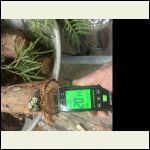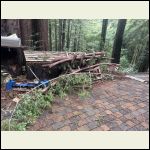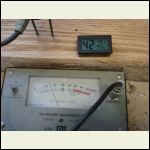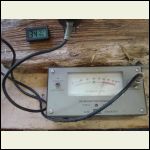| . 1 . 2 . >> |
| Author |
Message |
dogfish
Member
|
# Posted: 6 Feb 2025 02:40pm - Edited by: dogfish
Reply
I am in the process of building a log cabin, we fell the tree's last December (2023) and they were all stripped by April and since then I have rolled them a quarter of a turn at a time every few months. I had planned on setting them by now but the foundation is taking longer than expected and I am wondering how long is too long for drying? They are loblolly pine so not super resistant to rot. They are on log runners so they are not on the ground. My new goal is to be setting logs by this fall but it might not happen so is there anything I should do to protect them?
|
|
FishHog
Member
|
# Posted: 6 Feb 2025 04:38pm
Reply
There is no too much drying. Better dry before you build with them than them continuing to dry after.
|
|
gcrank1
Member
|
# Posted: 6 Feb 2025 04:43pm
Reply
Idk, but have heard about painting the ends of drying logs to minimize checking.....dont remember if for building logs though.
|
|
spencerin
Member
|
# Posted: 6 Feb 2025 07:47pm
Reply
Yeah, the drier the better. Keep 'em dry as much as you can until it comes time to set 'em.
|
|
Malamute
Member
|
# Posted: 6 Feb 2025 09:16pm
Reply
If theres any large cracks Id suggest turning them so they dont collect water.
|
|
Brettny
Member
|
# Posted: 7 Feb 2025 05:59am
Reply
I dont have any experience with that specific pine but I can tell you every soft or hard wood in the northeast dosnt dry in log form. They have a tendency just to rot if not covered.
|
|
DRP
Member
|
# Posted: 7 Feb 2025 08:32pm
Reply
In the early 1800's census' my ancestors listed their occupation as "turpentine", real tarheels. Between the 2 of us we have planted over a million lobs. Funny thing is, it was known in past times as oldfield pine. It would take over infertile plantation fields abandoned after being burned out on tobacco and corn. In my oldest engineering texts the strengths of the other major southern pines is given but loblolly, the red headed stepchild, wasn't mentioned. In my teens school kids collected seed from the best and in my 20's we were planting the improved seedlings like crazy. It is known for being one of the lesser checking pines.
If you can beg or borrow a shed roof to store them under it would be best. Short of that old tin on stickers over the top of the stacks would be good. Do not wrap in plastic or tarps, that just accelerates rot. At my sawmill I make long pallets that have roof underlayment and scrap tin screwed to them. Those are set on top of stacks of lumber that is air drying.
Borate would not hurt. You can buy bora-care or timbor but the ag nutrient solubor or beau-ron is identical at a fraction of the price from your local real farm supply.
If you snap a line along what will be the bottom and chainsaw a groove ~1/4 log depth the check will form there.
I've watched 2 log homes rot while the owner worked too slow, be realistic about time and abilities before getting in too deep.
End coating helps, slowing rapid drying from the end grain so that the moisture loss and shrinkage is more uniform. Likewise, live cool the first couple of winters to reduce rapid surface drying over a still green and swollen core. Lob is also one of the fastest drying woods as its tracheids are about 4 times the size of "average" hardwood vessels. Its moisture content is often above 100% when felled and can be up to 300%. Wood MC is based on current weight vs oven dry weight. Those big hollow cells contain a lot of free water.
|
|
dogfish
Member
|
# Posted: 10 Feb 2025 07:15am
Reply
Thank you all for the responses. Currently the logs sit un covered (which is how I read to do it) and I did seal the ends. So should I figure out a way to cover them or just leave them open air no cover? They very little checking so far.
|
|
|
ICC
Member
|
# Posted: 10 Feb 2025 09:13am
Reply
Quoting: dogfish So should I figure out a way to cover them or just leave them open air no cover
The responses above seem to include only one person who spoke of actual experience with air drying wood. They stated covering the wood with a roof or metal roofing sheets was best. How does that equate to you asking again if it is okay to leave uncovered?
FWIW, anyone here in northern NM with a saw mill has open sided but roofed pole structures for air drying, or they use roofing metal cover sections on top.
If you are looking for validation of best practice go ask on the forestry forum where logs and sawmills are a way of life for many.. https://forestryforum.com/board/index.php?action=agreement
|
|
dogfish
Member
|
# Posted: 11 Feb 2025 07:37am
Reply
Quoting: ICC How does that equate to you asking again if it is okay to leave uncovered?
I didn't get the answer I was looking for so I asked it a more specific way to try to get a more specific answer. I didn't realize this site had question police. I didn't ask about cut lumber but thanks.
|
|
DaveBell
Moderator
|
# Posted: 11 Feb 2025 09:37am
Reply
Dogfish, DRP gave an answer, cover with metal sheet or other to keep rain off but allow side ventilation. You then asked the question again. So I guess you missed it with the long post.
ICC, your reply was a bit too sharp. Just point out the recommendation. Nice like.
Dogfish, Drying logs takes one year per inch of thickness. So how many years for your thickest log?
|
|
DRP
Member
|
# Posted: 11 Feb 2025 12:06pm
Reply
Me? a long post? Its all good, if you'll bear with, its a 'sno day, there's always more, the fun of working with wood.
The old adage, which I grew up with too, "one year per inch of thickness"... you can air dry those faster drying woods, as boards, to equilibrium in good drying conditions in a months or two for something like lob or tulip poplar up here. The 2" thick from the same log sitting right beside it will take much more than 2x as long to reach emc... it is not a linear thing at all as thickness increases. Moisture moves through wood by diffusion and then is swept off the surface by airflow and lower humidity. The diffusion part takes time and is helped along by energy (heat). However loblolly is something else. I've used 2x SYP that was HiTemp kiln dried in 24 hours to 19%, which is framing materials dry. Those college boys have dialed that tree in.
... then there are woods like white oak that have shorter vessels that are blocked by tyloses (why your whiskey doesn't leak outta the barrel) but make for much slower and much more check prone drying. Those woods can leave all the rules of thumb behind.
Although it would be nice if the logs were fully dry before beginning that is rare in my experience. What technique are you using to build the walls? In other words any sawing or breaking of the surface across the rings of grain is going to speed drying. If that is going to happen call in the sawmill now and at least oversize roughly surface.
Drying well is somewhat of an art, some basic numbers to give a few guideposts.
Green is considered to be above ~19% MC(moisture content). That is about where things start to change with the wood/water relationship. If you are cutting firewood and notice a "dry" looking shell over a wet looking core you are seeing this "fiber saturation point". What is visible to the naked eye is "free water" This is water within the cell lumen, the hollow of the straw if we are thinking of a cell as a straw. At the moment when the visible moisture is gone but no more, that is the true FSP and is a cell by cell thing although we tend to refer to it as if it means the whole timber... its that diffusion thing, as the surface dries the free water moves to the surface to be swept off in the next breeze. That free water means nothing to the wood, it doesn't cause expansion or contraction BUT! that is the moisture that fungi live on. Job1 then is to get the surface below FSP as fast as possible to avoid giving stains and rotters a foothold. Most insects start losing interest as the mc drops as well, they have to adapt, carry a canteen or go to ground and that leaves many lightweight borers behind. Just getting the surface below fsp. If you keep drying too rapidly right then, shrinkage begins. The surface will shrink over the still fat core and that is the check. Don't shrink too fast, that is the tricky part, don't rot or stain from drying too slow, don't excessively check from going too fast. Open to the sun is too fast, always have a roof, never have sides with pine.
Something about checks, generally initiated above 40%mc and then seen well below that level, pay attention to overfast, sunny days with green timber. Green logs on a job in June and it gets loud. You know how it is hard to tear a piece of cloth till you get a rip started, same thing with checks once a check starts it can rip deep fast. Do your best to babysit wood early on to reduce the number or checks. I've put on a sacrificial coat of stain or BLO boiled linseed oil to moderate surface drying once you hit ~19%, check compatibility with final finish.
The remaining moisture is "bound water" within the woody cell wall and is loosely chemically bound to the cellulose. A cellulose sponge is close to pure free of all the natural glue and grain and we can see that thing rapidly shrink and swell as it dries and rewets, over and over, wood is the same there is just more other stuff than just cellulose, kind of inhibiting and directing the movement in response to moisture. Those are the things causing checking, warping, etc.
As the bound water is removed from within the cell wall, that is when the "microfibrils" making up a unit of cellulose move closer together. That is shrinkage.
The wood will leave the easy drying phase from green to FSP and then slow down and continue to dry and shrink until it reaches "Equilibrium Moisture Content" with respect to the environment it is in. In the Southeast that is generally average ~12% outside under roof and 8%mc inside in a conditioned space. If I dry to that range the wood is generally as stable to work with as I can make it.
The takeaway there is the shrinkage happens between FSP ~19% and EMC ~8%
I think there is merit to any level of drying, just don't do damage in that time. Will the core be fully dry by construction time, probably no. Does it need to be to reduce shrinkage and settlement? Or does getting some shell of wood partially dry at least help, especially if you get the shell somewhere below 19%?
|
|
paulz
Member
|
# Posted: 12 Feb 2025 08:38am
Reply
Good stuff DRP. A little beyond my attention span these days, but got me wondering, and perhaps you did mention it, but I think I need a gauge to measure my firewood MC, something like this. Any better types?
|
|
DRP
Member
|
# Posted: 12 Feb 2025 10:32am - Edited by: DRP
Reply
I tried to reread it... beyond mine too 
Pin type meters are good to the depth of the pins, those are 1/2". Cut the wood and then jab the pins to get readings at the core.
I've been told they are basically ohm meters reading in the range of billionths of an ohm of resistance. I clean and refresh the electrical lube on all fittings if I'm getting flakey readings.
My meter is just an analog version of the same type. The pins are 3" and insulated except at the tips. When they are going in you get a reading of the moisture gradient through a log or heavy timber. At the time some of the log home companies were using the term "dry" a little loosely.
The top left pic shows the dry shell/wet core... fiber saturation point on a freshly cut end. The rest showing a 90's analog meter, slide hammer for the pins and water running from these "kiln dry" timbers when an impact was driving a 3/8x10" lag 4" away.
|
|
paulz
Member
|
# Posted: 12 Feb 2025 10:51am
Reply
Let’s say I have a bunch of branches laying on the ground of undetermined time, under 6” diameter, which I have cut into 16” wood stove lengths and stacked. Can I just put the probes into the middle of the cut end and get a decent reading? Will that reading change as the log sits?
|
|
DRP
Member
|
# Posted: 12 Feb 2025 11:54am
Reply
End grain dries fastest and you have 1/2" probes so that would be an unusually low reading. If you split a piece and probe the freshly exposed core that would be a better reading.
|
|
paulz
Member
|
# Posted: 12 Feb 2025 06:26pm - Edited by: paulz
Reply
Well I bought one. What the heck, 20 bucks. I spend more than that on laxatives (used to be beer). If I cut a 16” log in half that end should measure up ok.
Thanks again DRP.
|
|
paulz
Member
|
# Posted: 13 Feb 2025 04:00pm - Edited by: paulz
Reply
Wow, got it already, Amazon quick here in gridville. The only piece of firewood here is a chunk of oak from a neighbor across from the cabin. I think it’s not that old because I’ve been burning it, doesn’t go that well. And the meter reads wet, 40. An old piece of fence board here measures 3%. The real testing comes when I get back out to the wood pile next week. New toys are fun.
|
|
DRP
Member
|
# Posted: 13 Feb 2025 08:10pm - Edited by: DRP
Reply
These are a couple of pages from moisture meter manufacturers on equilibrium moisture and wood/water relationships.
https://lignomatusa.com/emc/
https://www.wagnermeters.com/moisture-meters/wood-info/what-is-equilibrium-moisture-c ontent/
On one page the table had a grey section that encompasses the majority of our working range in houses. I remember the relative humidity to moisture content numbers and tend to ignore the temperature, in the "normal" range. If you look at the table you'll see why, humidity has a much larger role in wood moisture content than temperature when you're around room temperature. The fun science guy stuff to do is look at the temperature and humidity conditions of a space, look up what the moisture content is supposed to be, and then try to find a hidden place to give some wood a snakebite to confirm the EMC table with the meter. I've also checked my meter against fresh wood at the building supply, those kilns don't waste much energy, the wood will be close to the stamp either 19% or 15% when right off the truck.
|
|
paulz
Member
|
# Posted: 17 Feb 2025 10:11am
Reply
Complex subject for a dummy. 108%, would that apply to my redwood? No wonder I’m fighting the wood stove..
“For example, the average moisture content of green wood Douglas fir (Rocky Mountain type) is 43%, while it’s 108% for a California red fir. Similarly, the green heartwood of eastern white pine has an average moisture content of 50%, and the green heartwood of ponderosa pine averages 40% MC.”
|
|
gcrank1
Member
|
# Posted: 17 Feb 2025 11:29am
Reply
You got mostly steam coming out yer stack Paul?
|
|
paulz
Member
|
# Posted: 17 Feb 2025 01:06pm
Reply
Just looks like smoke. So I went up to check the water tank this morning, full from running the well pump last night, but several big branches on the ground, probably fell last winter. I drug them over to the log cutting jig and sliced them up.
Moisture meter reads only about 20, am I supposed to shove the pins in further than a light press?
I’ll throw one in the stove later, that should make some steam.
Also, to the left is the manual log splitter I’ve been using since the engine quit on the good one. It works ok but man what a workout on anything but redwood.
IMG_4391.jpeg
| 
IMG_4389.jpeg
|  |  |
|
|
gcrank1
Member
|
# Posted: 17 Feb 2025 03:04pm
Reply
Think of that splitter as your 'physical therapy'
|
|
DRP
Member
|
# Posted: 17 Feb 2025 06:15pm
Reply
Do bury the pins as deeply as you can... or to the depth you want to read from.
For that branch I would strip the bark back along the branch away from the end, then stab the pin in running with the grain, look at the orientation of the pins in my pic above, that is how most specify to take a reading.
Uninsulated pins (yours) are going to read from the lowest resistance points anywhere along their length. They will in other words give the wettest reading along the probe line. However, those are 1/2" pins and if you look at the pic above at the dry shell/wet core pic... get those short pins in as deep as possible or split the sample and still get them in enough to make good contact. I've used a drill with a small bit to get down close to depth on hard wood and then hand drive the last little bit to get good contact in unadultered wood.
There are a couple of ways to check the meter. There is a calibration standard available from Delmhorst. It is really 2 resistors, one corresponds to 12% the other to 22%. It is correct on all resistance meters and costs more than your meter.
If you have a good scale I can walk you through taking a "sample board" through the oven dry method. You meter the sample board then weigh it, dry it, reweigh and figure out the moisture content then compare it to the meter. That is going on all the time at large kiln operations. Those procedures mostly come from and are in articles from the USFPL. until they go dark
ROMoistureMeter.JPG
| 
WetOak.JPG
|  |  |
|
|
paulz
Member
|
# Posted: 17 Feb 2025 07:46pm
Reply
Ok, bark cut back, jammed in far enough to support itself.
|
|
DRP
Member
|
# Posted: 17 Feb 2025 08:09pm - Edited by: DRP
Reply
There we go, and that kind of shows how flakey moisture meter readings can be in the hands of the right used car salesman.
I misspoke earlier, and there is a college forestry text a foot from my hand that I chose not to open, hmm. The fiber saturation point varies by species from a low of about 18% for western redcedar to around 30%, the average is considered to be round 28%. Anyway, a reading above FSP is considered indicative rather than actual. In other words a reading that high is not true, it just means dang wet. For firewood when you get below 20% its good.
Oh, forgot to mention power came back on last night so from Tues afternoon to Sun night. The winds had built to about 50 mph towards dusk and I watched the outage map grow by about 10,000 customers in that hour or so and thought we would be pushed back again but they got us on. Hot showers all around  . .
|
|
paulz
Member
|
# Posted: 18 Feb 2025 10:33am
Reply
Thanks DRP, now I finally have a firewood measurement means and number.. This tool does seem well made enough, but came with an instruction booklet like many products now a 2”x2” paper folded over 10 times, with writing requiring a microscope.
Anyway good on getting the power back. You might take a look at gcranks Ecoflow power unit thread unless you already have a home genny.
|
|
gcrank1
Member
|
# Posted: 18 Feb 2025 11:43am
Reply
Paul, you have wood that burns pretty nice, right? How about taking a read with your new instrument on that and use it as your base line to compare other wood to.
|
|
paulz
Member
|
# Posted: 18 Feb 2025 12:00pm
Reply
I do. That firewood box pictured behind the log splitter above is full, year plus old stuff. It measures around 23, much better than 47! I’ve been saving it and burning stuff laying around thinking I’ll need it when winter gets really cold.. well it’s pretty cold!
|
|
gcrank1
Member
|
# Posted: 18 Feb 2025 12:37pm
Reply
Seems I read somewhere long ago that the amount of heat that it takes to cook the water out of firewood (loss of btu's) before it becomes heat producing is pretty substantial.
I wonder where that tipping point is?
|
|
| . 1 . 2 . >> |

